
Bats
Bats are important pollinators and the only flying mammals; they use sound to locate their prey, and they live a long time. Oregon has 15 species of bats, and eight of those are Oregon Conservation Strategy Species. Strategy Species are those having small or declining populations, are at-risk, and/or of management concern.
Some of Oregon's species migrate south in winter while some remain here and hibernate. Bats have echolocation which allows them to make high-pitched sounds then listen to the echo of those sounds to locate where objects are. Echolocation helps them find even the smallest insect.

Types of Bats
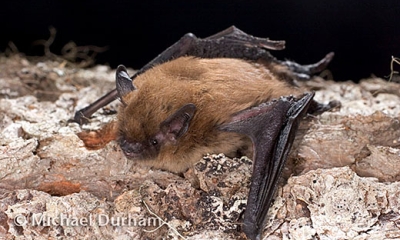
California myotis is an acrobatic flyer. It is dark brown to blond with dark ears, and feeds on moths and flies.
Early in the summer, a female joins a maternity or nursery colony where she gives birth to one offspring. In winter, these bats roost in mines, caves and buildings.
The California myotis is an Oregon Conservation Strategy Species found throughout the state except for the Columbia Basin.
Photo by ©Michael Durham
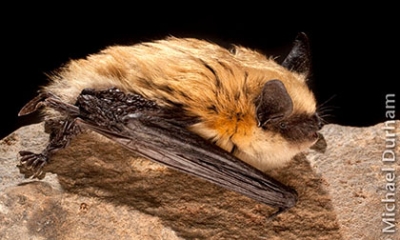
The Western small-footed myotis is among the smaller bats in Oregon and is brown to pale yellow with black ears and a black mask across its eyes and nose.
It lives in dry climates, especially cliffs and rocks, and forages back and forth along the face of cliffs. It hibernates in caves and mines from November through February.
In Oregon, the species only occurs east of the Cascade Range.
Photo by ©Michael Durham
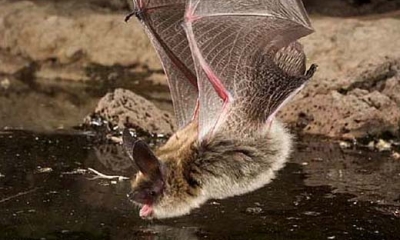
The long-eared myotis is pale brown to strawberry. It is a slow flier and hovers around trees and rocks to catch flies, moths and wasps.
It is primarily a bat of coniferous forests in much of Oregon but may occur far from trees in shrub-steppe regions of the state. It forages in openings in dense forest, between the trees beneath the canopy in ponderosa pine, and over willow-bordered creeks. The species is known to enter dwellings and other buildings through open windows and doors, and to forage on moths therein.
The long-eared myotis often day roosts in buildings, but may use many other natural and man-made structures including caves and mines, bridges, hollow trees and loose bark on trees, and fissures in rock outcrops. This bat is found throughout the state.
Photo by ©Michael Durham
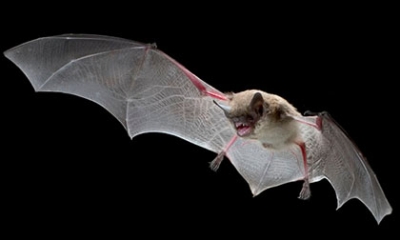
This bat is commonly found in attics and buildings during summer months in maternity colonies. It weighs about half an ounce and has a wingspan of nine to 11 inches. It prefers to live in forests near water.
One baby is born in spring or summer. In winter, this bat hibernates in caves.
The little brown myotis occurs throughout Oregon in a wide variety of habitats, but seems especially prone to establish residence near a lake, pond, or stream.
Photo by ©Michael Durham
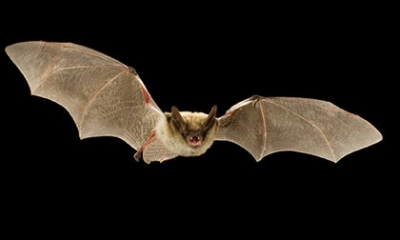
This bat is brown to reddish brown and has relatively long forearms. It gets its name from the fringe of hairs along the bottom of its tail.
It roosts in trees, snags, buildings, caves, rocks, cliffs and bridges. It likes beetles and moths but will eat spiders and crickets.
The fringed myotis occurs in the Coast Range from Jackson County to Clatsop County and in the northeastern corner of the state. It's an Oregon Conservation Strategy Species in seven of the nine ecoregions.
Photo by ©Michael Durham
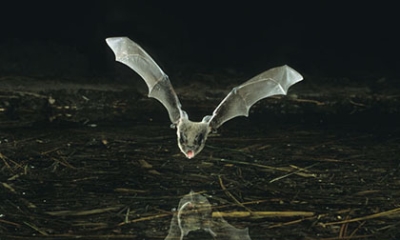
The long-legged myotis lives in forests and comes out early in the evening to hunt. It is a fast flier and will chase insects for a long distance.
One baby is born in the summer, and the species hibernates in winter.
In general, the long-legged myotis is a species associated with montane coniferous forests, but it also occurs in some desert and riparian habitats.
The long-legged myotis is an Oregon Conservation Strategy Species in these ecoregions: Blue Mountains, Coast Range, East and West Cascades, Klamath Mountains, and Northern Basin and Range.
Photo by ©Michael Durham
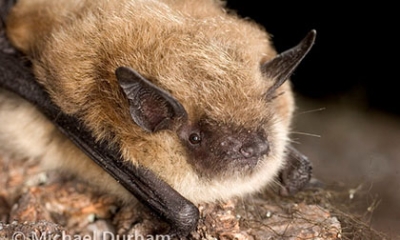
Yuma myotis emerges when it is almost dark and forages for insects over streams and ponds. This bat is gray, tan or brown; it lives in a variety of habitats.
Large numbers of female bats gather together in May or June to have their young. In autumn, they migrate.
Yuma myotis is found throughout the state and is associated more closely with water than any other North American species of bat.
Photo by ©Michael Durham

The hoary bat has a wingspan of nearly 16 inches. It has dark fur tipped with white, a dark mask on its face, a yellow-orange throat and round ears edged in black.
This bat roosts in branches of trees and likes to feed around outdoor lights. Hoary bats migrate south in winter, returning to Oregon in the spring. This bat usually bears twins.
Hoary bats are found at scattered localities over most of the region west of the Cascade Range and in montane regions east of the Cascade Range. They are an Oregon Conservation Strategy Species in all ecoregions except the Nearshore.
Photo by ©Michael Durham

This bat, found in older forests, has a wingspan of about 10 inches. Its fur is glossy black, tipped with white. It forages over ponds, streams, meadows and roads, often flying very low and roosting behind loose tree bark.
Maternity roosts of the silver-haired bat are found in trees. This bat usually bears twins.
The silver-haired bat occurs statewide in Oregon except for most of the Columbia Basin and is an Oregon Conservation Strategy Species in all ecoregions except the Nearshore ecoregion.
It is primarily associated with coniferous forests, including the juniper woodlands in the southeastern portion of the state. It sometimes occurs in mixed deciduous-coniferous forest, and during migrations in May and September it occurs in rangelands where it forages along small streams.
Photo by ©Michael Durham

The canyon bat weighs less than one quarter of an ounce! Its fur is pale yellow to brownish gray with a dark face mask.
It lives in eastern Oregon, likes rocky canyons and outcrops and flies early in the evening when it feeds on swarms of flying insects.
Photo by ©Michael Durham
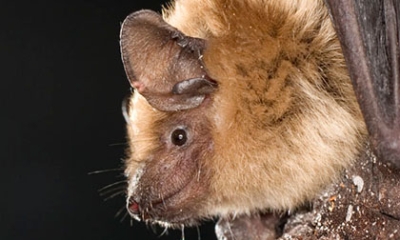
The big brown bat is a relatively large bat with a wingspan of 13 to 14 inches. Its dark color and slow flight help with identification. They are more likely to be active in cold weather than other bats and prefer human structures for roosting.
The big brown bat occurs throughout the state. In eastern Oregon it forages over the forest canopy, along roads through the trees, along the forest edge, over forest clearings, and along cliffs and canyon streams. In western Oregon, the species is usually associated with coniferous and deciduous forests.
Photo by ©Michael Durham

Spotted bats are rare in North America, living in dry climates and often roosting on high cliffs.
They are white underneath with dark fur on their back and with large white spots.
The spotted bat is found in eastern Oregon and is an Oregon Conservation Strategy Species in the Blue Mountains, Columbia Plateau, East Cascades, Klamath Mountains and Northern Basin and Range ecoregions.
Photo by ©Michael Durham
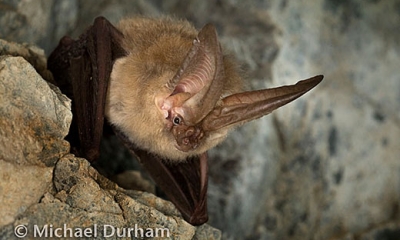
This is a medium-sized bat with large, long ears. It is gray, brown, or black and generally active only after full darkness.
Townsend's big-eared bat is very vulnerable to human disturbance, and its numbers are declining. In Oregon, it is classified as a State Sensitive Species. It's also an Oregon Conservation Strategy Species in all ecoregions except Nearshore.
Never disturb this bat if you are in a cave.
Photo by ©Michael Durham

This is a large, pale bat with huge ears, large eyes and a dog-like face. Its wing beat is slower than most bats.
It emerges late at night to feed primarily on the ground, eating large beetles, crickets, and even scorpions. Pallid bats can walk on the ground and are immune to a scorpion’s sting.
The pallid bat is uncommon and is found mostly in arid regions in canyons in southwestern and eastern Oregon. It's an Oregon Conservation Strategy Species in the Blue Mountains, Columbia Plateau, East Cascades, Klamath Mountains, and Northern Basin and Range ecoregions.
Photo by ©Michael Durham
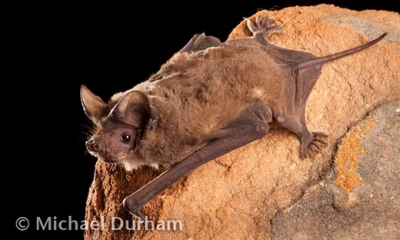
The Brazilian free-tailed bat is a fast-flying, medium-small bat with long narrow wings and a tail.
It survives the cold winters in Oregon by staying in heated buildings instead of hibernating or migrating, often sharing these quarters with other bat species.
Roseburg may be the most northern part of this bat’s range.
Photo by ©Michael Durham

